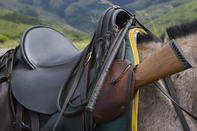A Volunteer Military Unit
Between the late 1800s and early 1900s business partners named Abel Erasmus and Org Basson operated a successful business transporting mine equipment between Lourenço Marques (Maputo) and the upcoming mines in the Gravelotte area.

An important resource in their business was their Geelbek oxen which Erasmus kept a breeding stock of on his farm, Orinoco, near the Mpisane Fort (named after Shaangaan Chief Mpisane Nxumalo) in Rolle near Thulamahashe.
While Erasmus and Basson’s business was in operation, a garrison of British soldiers was seconded to the area. The garrison, known as Steinaecker’s Horse, was a volunteer military unit that fought in the Anglo-Boer War between 1899 and 1902. They operated mainly in Swaziland and South Africa’s Lowveld. Harry Wolhunter, the famous Kruger Park game ranger was one of their members.
Christiaan Ludwig von Steinaecker

Steinaecker’s Horse was formed by a former Prussian-German soldier named Christiaan Ludwig von Steinaecker. Steinaecker came to South Africa in 1886 to work as a cartographer and eventually settled in Natal in 1890. In 1899 the Anglo-Boer War broke out and having extensive military experience, Steinaecker joined the Colonial Scouts. After his performance in a series of successful campaigns, he was noticed by the Commander of the British Forces, General Buller. Buller promoted Steinaecker to the rank of Major, gave him permission to raise his own cavalry unit and Steinaecker’s Horse was born.
Steinaecker’s Horse was made up of almost 600 men who were mostly local inhabitants of the Lowveld region. The unit was also assisted by local Swazi and Shangaan groups. The main purpose of the unit was to intercept the shipment of arms from the Dutch to the opposition in the Transvaal. They also burned down the homes of Boers suspected of assisting with the shipment of weapons to the opposition and gained the nickname The 40 Thieves after reportedly raiding the houses, keeping valuables for themselves.
Steinaecker's Horse Disbanded

Abel Erasmus crossed paths with Steinaeckers Horse when the garrison started stealing his oxen breeding stock in Rolle, which were then sent to locations around Barberton where the garrison had established a base. In response to the theft, Erasmus laid a formal charge with Boer Commander, General Ben Viljoen who sent Commandant Piet Moller to handle the situation.
Moller and his forces attacked Mpisane Fort, where Steinaecker’s Horse was stationed under Captain Francis Farmer. They were outnumbered, but the attack was successful and Farmer was killed. Steinaecker’s Horse was disbanded, some escaped after the attack, others surrendered and some, like Harry Wolhunter, remained and became largely involved with establishing the Kruger National Park.
Did You Know? The name Thulamahashe got its name from Steinaecker’s Horse. Thulamahashe means “dust of the horses”, referring to the dust that the horses created when riding out of Mpisane Fort.